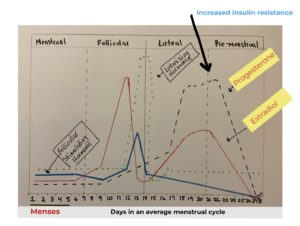I am a woman. I menstruate. And type-1 diabetes with menstruation is a challenge.
A huge challenge.
Sorry guys if this is too much TMI for you, but we women folk have hidden our natural cycles for far too long. In fact, it was the discomfort and veiled secret of “that time of month” that kept me from clearly understanding how to manage my type-1 diabetes with menstruation.
That’s an issue.

The secret that’s not a secret
I got my period when I was 14 years old; five years after my T1D diagnosis and right in the midst of my T1D denial years.
I remember wanting my period for a year before it finally came. This is because at 13, the first year of high school, so many of my new girlfriends were talking about it, mostly griping about it, and I felt completely left out. To be honest, though, despite health classes, and despite having an older sister, I didn’t really know what menstruation was about.
And so when it finally did arrive, and reality punched me square in the face, I came to the realization that it was all kinds of awful.
I struggled so greatly with debilitating cramps and nausea, profuse sweating, and moods – no amount of Ibuprofen was fixing that.
Shame also filled my insides. I did not want anyone to know, yet I thought everyone knew.
I remember a boy in high school making comments about girls smelling fishy. At that time, I thought he was speaking directly to me.
What in the holy hell?
And because of all of the above, I refused to look at my healthcare providers, including my diabetes team, when they tried discussing my period with me. I also refused to give more than one-word answers on the topic up until my early to mid 20s.
This is all sorts of wrong, and I fear that girls today are experiencing those same feelings that I did decades ago.
It’s time to change that.

Defining menses
Okay, just so we’re all on the same page, here’s the basic definition:
Menstruation usually starts in females between 12-14 years old, but can be as early as 8 and as late as 16.
It is a hormonal cycle that involves the shedding of the lining of the uterus. This causes a bloody discharge to flow from the uterus to the cervix and out the vagina.
The purpose of menses is to prepare the body every month for the possibility of pregnancy.
Did you see the bolded / highlighted / underlined hormonal part of the description above?
That is key to understanding the challenges of type-1 diabetes with menstruation.
The hormone effect

Menstrual cycles can last anywhere from 21 to 35 days, the average being 28 days.
The days that we want to focus on with regards to type-1 are days 17 to about 24, and days 1 to 5.
The aforementioned later days are considered the luteal / pre menstrual phases. This phase features a spike in the hormone progesterone as well as a lesser spike of estrogen.
The progesterone creates an environment of insulin resistance.
Whaaaaat?
Yes friends, that’s right. Anywhere from 1-2 weeks prior to your period, if you notice your blood sugars spiking, requiring more insulin than usual to manage, that may very well be the effects of progesterone.
It took me years to figure this mystery out. And that’s probably because I was so fearful and shamed to discuss my period.
I now have a self-learned system for managing my type-1 diabetes with menstruation. I have 2 basal settings: one for pre-menstruation and one for all other days. The pre-menstruation is currently set to provide 25% more basal than the other, however this value has been as low as 10% higher previously. I also give a slight ICR boost at breakfast, but no other meals.
When my blood sugars start consistently rising, I look back on when my last period was – thank you Health app! If it was 2-3 weeks prior, I’m fairly confident the cause is progesterone-induced insulin resistance, and I’ll input my pre-menstruation settings.
As soon as my period starts though, literally day 1 or 2, the progesterone is gone and my insulin sensitivity is greatly heightened. This is the menses phase, which usually covers day 1 to day 5 or 6.
During this phase, my insulin requirements are significantly reduced, and I’m often having to eat more foods to keep my blood sugars from going low – even with insulin reduction strategies.
Wow!
That is a lot of math!
Removing the stigma
My purpose for this post is to remove the stigma of periods. Girls and women alike need to know the freedom of understanding their type-1 diabetes with menstruation.
The only way that’s going to happen is by removing the stigma.
Men, you play a role in helping with this too. Don’t add to the shame. Try to learn as much as you can about this process, and be supportive in any way the females in your lives want you to be.
** Please note, my strategies above were specific to my type-1 diabetes with menstruation and were developed through personalized trial and error strategies. For specific support, reach out to your diabetes healthcare team.
